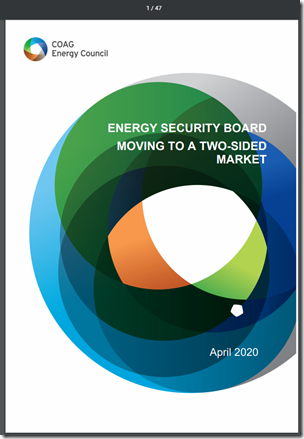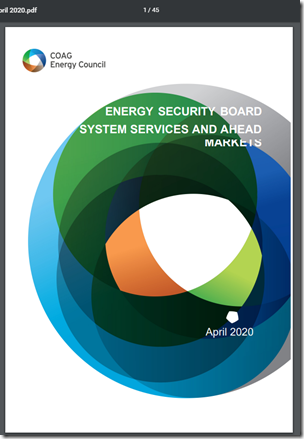In the December 2018 meeting of the COAG Energy Council this forward work plan was approved for the development of a ‘NEM 2.0’.
Sixteen months later (this week on Monday 20th April 2020) we were alerted that the COAG Energy Council had published these two papers that start to put more meat on the bones of the changes that are under consideration for what has been some fairly nebulous practicalities behind the “NEM 2.0” buzz and branding.
There is still a long way to go and a very tight timeframe in order to allow for the massive changes in systems, processes and tools that will be necessary for all participants in the new market:
| COAG Energy Council: ‘Moving to a two-sided market’ 20th April 2020 |
COAG Energy Council: ‘System Services and Ahead Markets’ 20th April 2020 |
| You can download this one here:
The COAG Energy Council notes here that they are asking for submissions by Monday 18th May 2020. Here’s the linked media release, for those who have an interest.
|
You can download this one here:
The COAG Energy Council notes here that they will be holding public consultation later in the year, but would welcome feedback on the paper. Here’s the linked media release, for those who have an interest. |
|
At this point I have only just skimmed what’s contained in the 47 pages and, other than noticing a degree of repetition in different places which makes the document longer than it might otherwise be, don’t have too much to add at this point with respect to what’s therein. It seems appropriate, however, to remind frequent readers of the exploration I shared about these two topics (i.e. ‘two-sided markets’ and ‘NEM 2.0’) in earlier articles here on WattClarity: On 5th March 2019 I posted ‘Some thoughts about Demand Response, in parallel with AEMC deliberations’ – within which I expressed significant concern about what was proposed in terms of a Negawatt Dispatch Mechanism (which would actually, in my view, take us further away from a properly functioning two-sided market). This was then followed on 21st October 2019 with ‘All aboard the Negawatt Express … but where are we really headed?’ where I reiterated the concerns that: Worth also noting that the AEMC published (on 14th November 2019) an information paper under the heading ‘eBay-ing Australia’s energy market’.
.
|
I’ve not yet even had time to open this one up, but I did have three general thoughts/questions just in reading the title: Question #1 = what are ‘System Services’? I assume the paper has an answer to this question (but again have not had time to look). The name reminds me of the naming we coined (with GVSC) in our widely-read Generator Report Card 2018, in which we used the term ‘Keeping the Lights on Services’ The ESB was one of a large number of organisations that purchased access to the GRC2018 so I will be interested to read what they see as ‘System Services’. Question #2 = what are ‘Ahead Markets’? Once again, I assume that the answer is inside the paper. In this case, the specific choice of naming does seem to suggest that some within the ESB have already made their minds up that the NEM requires a ‘Day-Ahead Market’ of a form similar to that which is in place in other parts of world. I’ve not read the paper, but I would have thought that the term ‘Forward Market’ (which is commonly understood around the world) would have been a better choice of name, as it would be more likely to help the reader first identify the problem to be solved rather than immediately flipping into solution mode with a more narrow frame of reference? Thought #3 = There’s two big (and separate) questions in one If the two terminologies are intended to mean what I think they mean, then I would have thought it better to present them in two separate papers (i.e. making it three papers and not two) as my sense is that they are really two different types of challenges: Challenge 1 = with a move (especially pronounced in the NEM) to the promotion of ‘Anytime/Anywhere Energy*’ there is an increasing need for separate incentivisation of ‘Keeping the Lights on Services’. I expect this paper discusses this. >> * ‘Anytime/Anywhere Energy’ was the name we coined in the GRC2018 to describe the type of energy being increasingly promoted in the NEM by forms of incentives that work to obscure explicit links to both: Challenge 2 = As a separate challenge, there is also a growing need to focus more on the firmness of offers to supply energy at future points in time – again coming about due to different aspects of the energy transition we’re working through as a live experiment. … but then maybe I have misinterpreted the title (I have not had a chance to read yet). |
| Published on the AEMC website on 20th April 2020 I’ve just found* this Media Release on ‘What next for a two-sided energy market? The implications of venturing behind the meter’.
* the structure of the AEMC website is not great for ensuring that content is easy to find. Would be nice if all content pertaining to a topic (e.g. ‘two-sided market’) could be found under the same heading! Thursday 23rd April 2020 = On the AEMC website on Thursday 23rd April , it was noted that consultation was open with a request that written submissions be submitted by Monday 18th May 2020 (i.e. a little over 3 weeks away). Given our track record (perhaps only 1 formal submission in 20 years) it is highly unlikely that we’d make a formal submission. Much more likely is that (if time permits us to review in more detail) we’d post further thoughts here on WattClarity®. I note also that the AEMC page says:
. As we find other pieces of discussion that we see as particularly relevant with respect to two-sided markets (and we remember to do so) we will look to link them in here, as a ready reference for our future use. |
Also published on the AEMC website on 20th April 2020 was this Media Release on ‘Thinking ahead: Options for boosting reliability and security in the National Electricity Market’.
. As we find other pieces of discussion that we see as particularly relevant with respect to two-sided markets (and we remember to do so) we will look to link them in here, as a ready reference for our future use.
. |
As the final point for today, I would remind readers that the questions which I believe are posed in these two papers (covering three big issues) are in the same family of questions that were being considered by market operators as far ago as 1997 when I had some involvement in the international organisation, the Association of Power Exchanges (APEX is now here).
I make this reminder that these are not simple problems, and that they have not ever been ‘solved’, in a permanent sense, anywhere around the world in what’s now 30 years of electricity market operations.




Thanks Paul